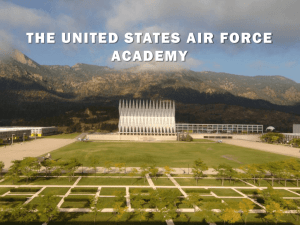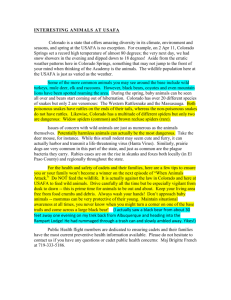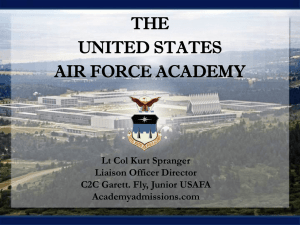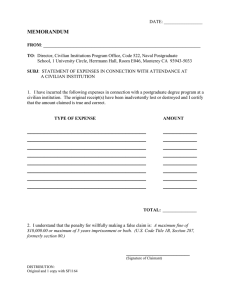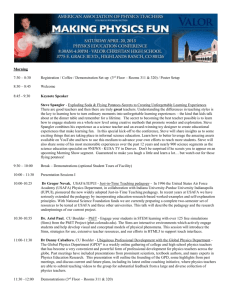The RAND Corporation is a nonprofit institution that research and analysis.
advertisement
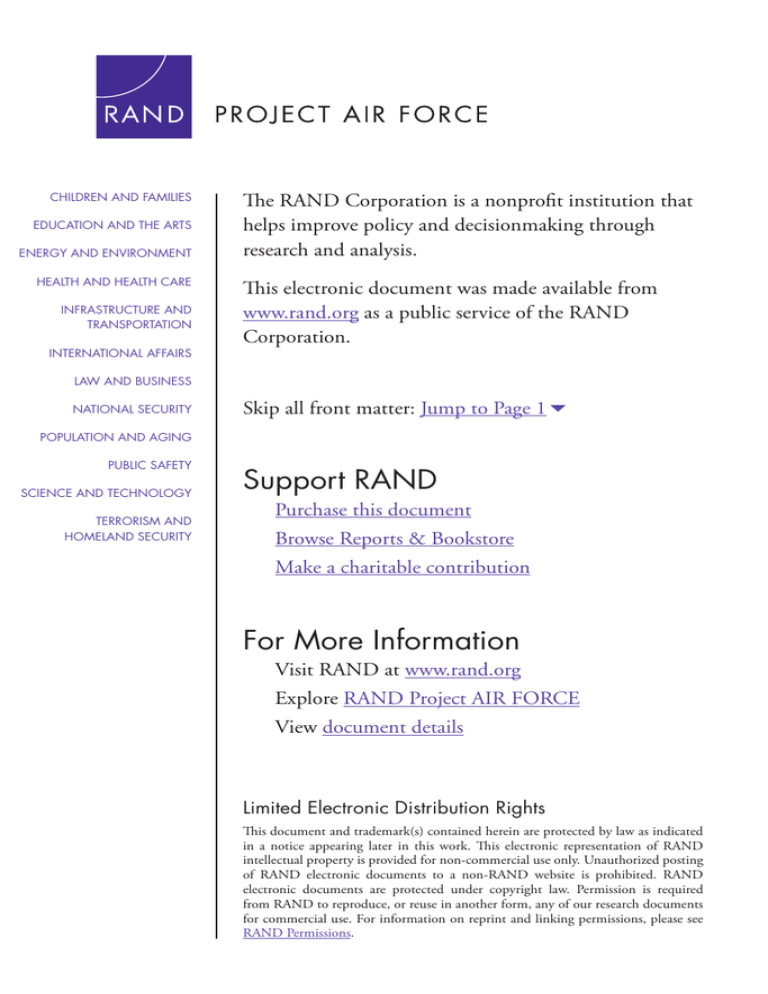
CHILDREN AND FAMILIES EDUCATION AND THE ARTS ENERGY AND ENVIRONMENT HEALTH AND HEALTH CARE INFRASTRUCTURE AND TRANSPORTATION INTERNATIONAL AFFAIRS The RAND Corporation is a nonprofit institution that helps improve policy and decisionmaking through research and analysis. This electronic document was made available from www.rand.org as a public service of the RAND Corporation. LAW AND BUSINESS NATIONAL SECURITY Skip all front matter: Jump to Page 16 POPULATION AND AGING PUBLIC SAFETY SCIENCE AND TECHNOLOGY TERRORISM AND HOMELAND SECURITY Support RAND Purchase this document Browse Reports & Bookstore Make a charitable contribution For More Information Visit RAND at www.rand.org Explore RAND Project AIR FORCE View document details Limited Electronic Distribution Rights This document and trademark(s) contained herein are protected by law as indicated in a notice appearing later in this work. This electronic representation of RAND intellectual property is provided for non-commercial use only. Unauthorized posting of RAND electronic documents to a non-RAND website is prohibited. RAND electronic documents are protected under copyright law. Permission is required from RAND to reproduce, or reuse in another form, any of our research documents for commercial use. For information on reprint and linking permissions, please see RAND Permissions. This product is part of the RAND Corporation monograph series. RAND monographs present major research findings that address the challenges facing the public and private sectors. All RAND monographs undergo rigorous peer review to ensure high standards for research quality and objectivity. The Mix of Military and Civilian Faculty at the United States Air Force Academy Finding a Sustainable Balance for Enduring Success Kirsten M. Keller, Nelson Lim, Lisa M. Harrington, Kevin O'Neill, Abigail Haddad Prepared for the United States Air Force Approved for public release; distribution unlimited PROJECT AI R FORCE The research described in this report was sponsored by the United States Air Force under Contract FA7014-06-C-0001. Further information may be obtained from the Strategic Planning Division, Directorate of Plans, Hq USAF. Library of Congress Cataloging-in-Publication Data is available for this publication. ISBN: 978-0-8330-7693-9 The R AND Corporation is a nonprofit institution that helps improve policy and decisionmaking through research and analysis. R AND’s publications do not necessarily reflect the opinions of its research clients and sponsors. R® is a registered trademark. Cover image courtesy of U.S. Air Force/Mike Kaplan. © Copyright 2013 RAND Corporation Permission is given to duplicate this document for personal use only, as long as it is unaltered and complete. Copies may not be duplicated for commercial purposes. Unauthorized posting of RAND documents to a non-RAND website is prohibited. RAND documents are protected under copyright law. For information on reprint and linking permissions, please visit the R AND permissions page (http://www.rand.org/publications/ permissions.html). Published 2013 by the RAND Corporation 1776 Main Street, P.O. Box 2138, Santa Monica, CA 90407-2138 1200 South Hayes Street, Arlington, VA 22202-5050 4570 Fifth Avenue, Suite 600, Pittsburgh, PA 15213-2665 RAND URL: http://www.rand.org To order RAND documents or to obtain additional information, contact Distribution Services: Telephone: (310) 451-7002; Fax: (310) 451-6915; Email: order@rand.org Summary The mission of the United States Air Force Academy (USAFA) is “to educate, train and inspire men and women to become officers of character, motivated to lead the United States Air Force in service to our nation.”1 To achieve this mission, USAFA provides cadets (roughly 4,500 students) with military training as well as a four-year college education similar to that offered at other civilian institutions.2 Military training is overseen by the Commandant of Cadets (who holds the rank of brigadier general) and a staff of roughly 300, while academic instruction is overseen by the Dean of Faculty (who holds the rank of brigadier general) and an academic faculty of close to 600. Unlike at civilian institutions, USAFA academic classes are taught by a mix of active-duty military officers and civilian professors. At the time of this research, USAFA was authorized for 570 academic faculty members, with a mix of 71 percent military and 29 percent civilian. However, taking into account all temporary faculty members, the actual composition was closer to 37 percent civilian during the 2011 spring semester, when this research was conducted. Initially, the USAFA academic faculty was composed of activeduty military officers only. Civilians were formally incorporated in the early 1990s, composing up to roughly 25 percent of the faculty, at the urging of Congress in response to concerns over the highly rota- 1 U.S. Air Force Academy, The United States Air Force Academy Outcomes, Colo., 2009. 2 USAFA is an undergraduate-only institution. xv xvi The Mix of Military and Civilian Faculty at the United States Air Force Academy tional nature of military faculty and a lack of doctoral degrees.3 Since that time, the debate over the best mix of military and civilian faculty to achieve the Academy’s mission has continued, with USAFA’s current senior leaders preferring to maintain a majority-military faculty. However, the Air Force currently faces difficulty in meeting USAFA military faculty requirements for officers with advanced academic degrees, often resulting in understaffed departments. This report attempts to address these issues by strategically examining and providing recommendations for an academic faculty composition that balances key factors and is sustainable into the future. Specifically, it examines how general shifts in the current authorized academic faculty composition would affect five key factors of importance to both USAFA’s mission and the broader U.S. Air Force: 1. cadets’ officership development: the extent to which cadets are socialized into the Air Force culture and the role of being an officer 2. cadets’ academic development: the extent to which cadets are provided a rigorous and intellectually challenging education 3. cost: the cost to the government of employing military officers compared with employing civilians as faculty members 4. staffing challenges: the ability to meet academic faculty staffing requirements 5. officer career development: the impact of USAFA instructor duty on the professional development of officers who are sent to teach. This research draws on information from a wide range of sources, including interviews with senior leaders at USAFA, faculty focus groups, a survey of cadets, data on relative teaching effectiveness, information on faculty costs, and administrative personnel data. 3 Military faculty members serve in three- to four-year teaching tours. Summary xvii Cadets’ Officership Development The first factor we examined was cadets’ officership development. Findings from our interviews with USAFA senior leaders and focus groups with current faculty indicate that military faculty members play a key role in cadets’ officership development; they serve as role models, bring operational experience to the classroom, and provide career advice. Results from a cadet survey further support this distinction in faculty roles. Although differences were often small, cadets rated military faculty members as having a greater influence than civilian faculty on aspects of their officer development. Cadets’ Academic Development In terms of cadets’ academic development, we were not able to find conclusive evidence of differences in teaching effectiveness across faculty types. The cadet survey results also showed only minimal differences in how cadets perceive the influence of faculty groups on their intellectual skill development and the extent to which different faculty groups bring greater academic depth of knowledge to the classroom. However, findings from our interviews with USAFA senior leaders and focus groups with current faculty indicate that civilian faculty members play a key academic role at USAFA that military faculty members are not able to fill in the same way; they provide academic expertise, teaching experience, and a connection to the broader academic and research communities. The majority of civilian faculty members also hold doctorates, have greater teaching experience, and tend to hold higher academic ranks than military faculty. Cost We examined the average annual cost to the government of employing military officers and civilians as faculty members. The costs used for this analysis included both direct compensation paid to the military or xviii The Mix of Military and Civilian Faculty at the United States Air Force Academy civilian faculty member and indirect compensation costs incurred by the government, such as retirement accrual, health insurance, and relocation expenses. We also included the cost of obtaining an advanced academic degree for military officers, given that a majority of military faculty members were sponsored by USAFA to obtain their advanced academic degree to be qualified to teach. When comparing the relative cost to the government of employing a military or civilian faculty member, our calculations show that, on average, the least costly military faculty member (captain/O-3 direct hire with no Air Force– funded degree) is more expensive than a civilian instructor, assistant professor, or associate professor. If an Air Force officer (irrespective of grade) is sent for any Air Force–funded degree (master’s or doctorate), he or she is, on average, more costly than a civilian faculty member at the highest academic rank (professor). Staffing Challenges Currently, the Air Force faces difficulty in meeting USAFA’s staffing requirements for military faculty. This is due to several different factors, including a lack of officers with the necessary advanced academic degrees, staffing allocation plans that prioritize other billets over USAFA, and misalignment with career paths, and deployments. Further, due to budget limitations, funding for temporary faculty to fill empty positions is also being reduced. Officer Career Development Finally, our analysis of the impact of USAFA instructor duty on officer career development indicates that faculty tours at USAFA do not always fit designated career paths and result in missed opportunities to gain operational and command experience compared with nonfaculty peers. This is particularly true when officers obtain both a master’s degree and doctorate and complete two payback teaching tours at USAFA. Consistent with this finding, promotion analyses indicated Summary xix that those who taught at USAFA only as company-grade officers had better overall advancement rates to higher pay grades than officers who taught at USAFA as field-grade officers only or officers who taught as both company-grade and field-grade officers. This suggests that it is better for officers to teach at USAFA early in their careers as companygrade officers. However, there is a misalignment in manpower grade authorizations and assignments at USAFA, with company-grade officers currently understaffed and lieutenant colonels/O-5s overstaffed. Company-grade officers are not understaffed across the Air Force, however. Instead, challenges related to the timing of degrees, career paths, and different staffing prioritizations contribute to the misalignment at USAFA. Practices leading to this misalignment in manpower grade authorizations and assignments must be addressed to avoid a negative impact on officer career development. Conclusion and Policy Recommendations Table S.1 lists five potential staffing options reflecting general shifts in the percentage of authorized military and civilian faculty positions and the current misalignment in manpower authorizations and assignments. We examined the impact that each of these shifts would have on the five factors presented earlier, compared with maintaining current faculty authorizations. As the table shows, although keeping the current authorized percentages of military and civilian faculty members would have a neutral impact across all factors, this option is not sustainable and is undesirable for USAFA. It would perpetuate the staffing challenges USAFA currently faces in finding military officers with the appropriate advanced academic degrees, as well as the staffing practices that negatively affect officer career development. Looking across the other options, increasing civilian representation has a positive impact across many factors, and working to fill current company-grade authorizations will help officer career development. xx The Mix of Military and Civilian Faculty at the United States Air Force Academy Table S.1 Impact of Staffing Options on Five Key Factors Staffing Options Cadets’ Cadets’ Officership Academic Development Development Cost Officer Staffing Career Challenges Development Keep current military-civilian ratio Keep current military-civilian ratio; fill company-grade authorizations Increase % of military faculty Increase % of civilian faculty Increase % of civilian faculty; fill company-grade authorizations Unsustainable Negative impact Potential negative impact Neutral Potential positive impact Positive impact Based on this analysis, we developed the following four recommendations. It is important to note that we treated all factors equally in developing our recommendations. The Air Force will ultimately need to make strategic decisions regarding which factors are the highest priorities. Recommendation 1: A shift toward greater civilian representation is advisable unless its potential negative impact on building cadet officership outweighs the other factors. As illustrated in Table S.1, increasing the authorized percentage of civilian faculty would have a positive impact across many factors. Despite the potential negative impact on cadets’ officership development, cost and staffing challenges would be reduced, and there is a potential positive impact on academics, assuming that high-quality civilians are hired. Our analysis did not point to any silver-bullet ratio of military to civilian faculty. Summary xxi However, if the Air Force chooses to shift toward greater civilian representation, one option that should have little negative impact is to gradually increase civilian representation to roughly 40 percent of the authorized positions, reflecting current faculty operating conditions at the time of our research when including all temporary faculty (roughly 37 percent civilian in total). Recommendation 2: The mix of military and civilian faculty should vary across departments, with military representation concentrated in academic disciplines that are needed elsewhere in the Air Force. Finding military faculty with the appropriate advanced academic degrees to teach in academic departments that are not directly aligned with an Air Force specialty or highly utilized in the broader Air Force (e.g., philosophy, history) is very challenging. Therefore, we do not recommend a one-size-fits-all ratio across departments. This approach would also help provide better payback for the costs of Air Force–sponsored advanced academic degrees. Recommendation 3: Align military faculty assignments with manpower grade authorizations by filling current authorizations for company-grade officers. Our research indicates that having been an instructor at USAFA early in one’s career is less likely to hinder the career development of officers. Thus, it is important for officers who teach at USAFA to do so early in their careers. Of course, there may be initial challenges to achieving this realignment, including coordination between the Air Force Personnel Center and USAFA and ensuring that officers are obtaining their advanced academic degrees early enough to have the opportunity to fulfill instructor duty while they are junior officers. Recommendation 4: The Air Force should monitor and assess the impact of any changes to the current military and civilian faculty mix on USAFA’s ability to fulfill its mission. As USAFA implements changes to the composition of its faculty, it will be important to monitor any potentially negative effects on the factors examined as part of this research, the key outcomes identified by USAFA as part of its strategic plan, and the overall ability of USAFA to fulfill its mission. In conclusion, when holding all factors equal, we believe that a shift in the faculty ratio toward greater civilian representation will not xxii The Mix of Military and Civilian Faculty at the United States Air Force Academy be harmful to USAFA but will instead have the most positive impact. Taken together, we believe that these recommendations will result in a USAFA faculty that is better able to help the Academy meet its mission and is more sustainable into the future.
